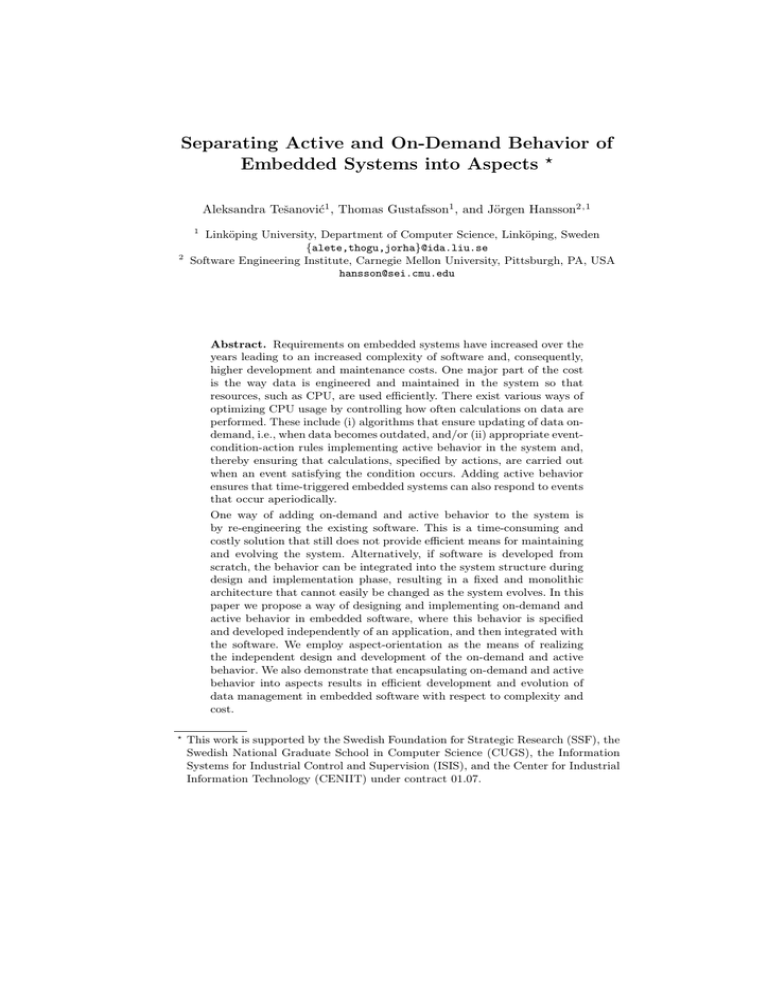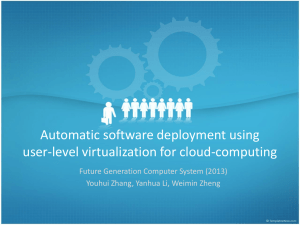Separating Active and On-Demand Behavior of Embedded Systems into Aspects ? Aleksandra Teˇsanovi´c
advertisement

Separating Active and On-Demand Behavior of
Embedded Systems into Aspects ?
Aleksandra Tešanović1 , Thomas Gustafsson1 , and Jörgen Hansson2,1
1
2
Linköping University, Department of Computer Science, Linköping, Sweden
{alete,thogu,jorha}@ida.liu.se
Software Engineering Institute, Carnegie Mellon University, Pittsburgh, PA, USA
hansson@sei.cmu.edu
Abstract. Requirements on embedded systems have increased over the
years leading to an increased complexity of software and, consequently,
higher development and maintenance costs. One major part of the cost
is the way data is engineered and maintained in the system so that
resources, such as CPU, are used efficiently. There exist various ways of
optimizing CPU usage by controlling how often calculations on data are
performed. These include (i) algorithms that ensure updating of data ondemand, i.e., when data becomes outdated, and/or (ii) appropriate eventcondition-action rules implementing active behavior in the system and,
thereby ensuring that calculations, specified by actions, are carried out
when an event satisfying the condition occurs. Adding active behavior
ensures that time-triggered embedded systems can also respond to events
that occur aperiodically.
One way of adding on-demand and active behavior to the system is
by re-engineering the existing software. This is a time-consuming and
costly solution that still does not provide efficient means for maintaining
and evolving the system. Alternatively, if software is developed from
scratch, the behavior can be integrated into the system structure during
design and implementation phase, resulting in a fixed and monolithic
architecture that cannot easily be changed as the system evolves. In this
paper we propose a way of designing and implementing on-demand and
active behavior in embedded software, where this behavior is specified
and developed independently of an application, and then integrated with
the software. We employ aspect-orientation as the means of realizing
the independent design and development of the on-demand and active
behavior. We also demonstrate that encapsulating on-demand and active
behavior into aspects results in efficient development and evolution of
data management in embedded software with respect to complexity and
cost.
?
This work is supported by the Swedish Foundation for Strategic Research (SSF), the
Swedish National Graduate School in Computer Science (CUGS), the Information
Systems for Industrial Control and Supervision (ISIS), and the Center for Industrial
Information Technology (CENIIT) under contract 01.07.
1
Introduction
Embedded systems constitute a majority of computing systems today and can
be found in a variety of applications, from domestic appliances to engine control. They are characterized by sparse memory capacity and requirements on
efficient CPU utilization. Furthermore, the majority of calculations in such systems are required to be finished before a given deadline to avoid performance
degradation. For example, the engine of modern cars is controlled by software
that continuously monitors and controls the engine using actuators. The control
computations, e.g., fuel injection, must be finished within a certain deadline,
otherwise the performance of the engine decreases, and in the worst-case the
engine breaks down.
Requirements, functional and non-functional, on embedded systems have increased over the years leading to a crescent complexity of software and, thereby,
resulting in higher development and maintenance costs [1, 2]. One major part
of the cost is the way data is maintained in the system. The requirements and
ways of handling data vary depending on the target application needs. Often it
is necessary to fine-tune data management of an embedded system by incorporating various methods and algorithms that ensure freshness of data, i.e., ensure
that data is up to date [3–5]. The algorithms are not a part of the original functionality of the system, rather they can be added to the system when the need
to optimize the overall available CPU occurs.
Typically one optimizes CPU usage by adding so-called on-demand algorithms that dynamically adjust the update frequencies of data based on how
rapidly sensor values change in the environment. On-demand behavior ensures
that data is updated only when it is no longer fresh [4] (this is in contrast
to approaches [6–9] where sensor values are always updated when data is assumed to become obsolete at the end of a constant time period, representing
the worst case). As the system evolves, more elaborate schemes for data management might be applicable [10]. Namely, adding active behavior to the system
in terms of event-condition-action rules is essential to embedded applications
that are time-triggered but require actions on data to be performed even when
a certain event occurs, e.g., when the engine overheats appropriate updates on
data items should be triggered to ensure cooling down. Each rule in the eventcondition-action paradigm reacts to certain events, evaluates a condition, and
based on the truth value of the condition, might carry out an action [11]. As
active behavior is often dependent on on-demand behavior, it is also important
to enable incremental evolution of the system. Also, since embedded systems
are evolving rapidly, the number of data items is also increasing, requiring an
efficient way of evolving the mentioned behavior in the system.
When the CPU usage needs to be optimized by means of adding on-demand
or active behavior, one way is to re-engineer a system. This is a time-consuming
and costly solution that does not provide efficient means for maintaining and
evolving the system. Alternatively, if software is developed from scratch, the
behavior can be integrated into the system structure during design and implementation phase, resulting in a fixed and monolithic architecture that cannot
easily be changed as the system evolves. Hence, an efficient way of designing,
implementing, and integrating different behaviors that enable fine-tuning of data
management and consequently optimizes CPU usage is needed.
In this paper we propose a way of handling design and implementation of ondemand and active behavior, where this behavior is designed and implemented
independently of an application and then integrated with software for fine-tuning
the CPU usage. As we show, the crosscutting nature of the on-demand and
active behavior is a good candidate for the use of aspect-oriented programming,
which allows us to encapsulate these behaviors into aspects. We also demonstrate
that encapsulating on-demand and active behavior into aspects results in more
efficient development and evolution of data management in embedded software.
The paper is outlined as follows. In section 2 we give background information
about embedded software systems and aspect-oriented programming. Section 3
presents the design and development of on-demand and active behavior using
aspects. Finally, in section 4 we give the main conclusions.
2
Background
In this section we present main characteristics of embedded software and give
brief introduction to aspect-oriented programming.
2.1
Characteristics of Embedded Systems
Here we give an overview of a software controlling a vehicle, which is our target
application. A vehicle control system consists of several electronic control units
(ECUs) connected through a CAN communication link [12, 4]. The number of
ECUs can vary depending on the way functionality is divided between ECUs for a
particular type of the vehicle. One typical example of an ECU is the engine ECU
(EECU). The memory of the EECU is limited to 64kb RAM and 512kb Flash.
The 32-bit CPU runs at 16.67MHz. The EECU is responsible for controlling
the engine. For example, the EECU controls the fuel injection and spark plug
ignition in order to have an optimal air-fuel mixture for the catalyst, and to
avoid knocking of the engine (knocking is a state where the air-fuel mixture is
misfired and can destroy the engine). Data that the system reacts upon, e.g.,
temperature and air pressure, is collected from the engine environment in fixed
and pre-defined periods of time and are spread out in different modules over the
system. All data items in the software are known before the system start and they
often have requirements on freshness. Data is considered to be fresh if a value of
a data item is a correct reflection of the state of the external environment.
2.2
Aspect-Oriented Programming
Aspect-oriented programming allows separating and encapsulating system’s crosscutting concerns into modules, called aspects [13]. The main constituents of
aspect-oriented programs are: (i) components, written in a component language,
e.g., C, C++, and Java; (ii) aspects, written in a corresponding aspect language,
e.g., AspectC [14], AspectC++ [15], and AspectJ [16]; and (iii) an aspect weaver,
which combines aspects with components.
An aspect in an aspect language consists of pointcuts and advices. A pointcut
consists of one or more join points, and it is described by a pointcut expression.
A join point refers to a point in the component code where aspects could be
woven, e.g., a method, a type (struct or union). An advice is a declaration used
to specify the code that should run when the join points, specified by a pointcut
expression, are reached. Different kinds of advices can be declared, such as:
(i) before advice code is executed before the join point, (ii) after advice code
is executed immediately after the join point, and (iii) around advice code is
executed in place of the join point. A special type of an advice, called inter-type
advice or an introduction can be used for adding members to the structures or
classes.
3
Designing and Implementing Active and On-demand
Behavior for Evolution and Reuse
In this section, after reviewing what is needed (data structures and rules) for
active and on-demand behavior, we present the way on-demand and active methods can be designed and implemented using aspects. We also discuss concrete
implementation issues and identify challenges.
3.1
On-Demand and Active Behavior
In embedded systems that monitor a natural environment data items managed
by the system can be divided into (i) base data items, which are read from sensors
or communication links, and (ii) derived data items, which are calculated from
a set consisting of base items and derived data items.
Since the values of one calculation depend on values derived by other calculations, calculations have precedence constraints that are described by a directed
acyclic graph (DAG), denoted data dependency graph (see figure 1). Base items
have zero in-degree, and nodes representing actuator values have zero out-degree.
Furthermore, if a calculation derives a value of only one data item then there
exists a simple mapping from precedence constraints in a DAG to calculations
of data items.
The majority of embedded systems is time-triggered [17], implying that all
calculations on data in the system are done in pre-defined periods of time (as
elaborated in section 2.1). This in turn means that memory and CPU resources
might be ineffectively used due to unnecessary updating of data items. Using
the example from figure 1, periodical updates of b1 always result in periodical
updates of d1 , d5 , and d6 , regardless of the data condition, i.e., whether data
is up-to date or not. To ensure that derived data items are updated only when
they are stale, on-demand approaches to data updating can be used.
b1
b2
d1
b3
d2
DVB1
b4
b6
d3
DVB2
E-C-A2
E-C-A1
b5
b7
d4
DVB4
DVB3
E-C-A4
E-C-A3
LEGEND
bi
i-th base data item
di
i-th derived data item
DVBi
d5
d6
DVB5
d7
DVB6
E-C-A5
E-C-A6
d8
DVB7
E-C-A7
DVB8
Data Validity Bound of
the i-th data item
E-C-Ai
E-C-A8
Event-ConditionAction coupling for
the i-th data item
d9
DVB9
E-C-A9
Fig. 1. Data in an embedded software system
In these approaches data freshness is implemented by associating every derived data item with the data validity bound (DVB) (see figure 1), which specifies
the allowed distance between two values of the same data. For example, associating data item d3 with the bound DV B3 =9 implies that the data is fresh and
should not be updated as long as the difference between the old and the new
value is less then 9. Now base data items are updated in fixed periods, and at
the time of the update they are checked for freshness [4]. If a base data item is
stale, i.e., its value is outside its DVB, the base data items’ immediate children
are marked for an update. These markings also apply for derived data items.
Thus, when a derived data item is updated its freshness is checked, and if it is
stale, the immediate children are marked.
When a need for an update of a derived data item occurs, e.g., when a
transaction in the system starts executing, then an algorithm (e.g., ODTB [4])
schedules data items that need to be updated based on their markings.
If the data dependency graph in the system is complex with inter-dependencies among data such that there is no path from one data item to another, then ondemand algorithms are not enough. Consider, for example, that the data item d9
in figure 1 is the temperature of the engine, and data item d8 contains values to
be displayed on the driver’s display. If the engine temperature reaches a certain
threshold, then the driver should be warned. That is, an update on data item
d9 might trigger an update on d8 if the threshold condition is satisfied. In this
case we need to incorporate event-condition-action rules into data management.
Namely, each data item should be associated with an event (e.g., on performed
calculations when data value changes), and the condition that triggers an action, i.e., some other calculation on another data item. Hence, each data item
should be augmented with meta-data information containing the condition and
an action (here we assume that an event is the updating of data item).
3.2
On-demand and Active Aspects
The way on-demand behavior can be implemented using an aspect is shown in
figure 2(a). As can be seen, the meta-data of data items (e.g., DVBs) is now
added via inter-type advices that add members to structures describing data
dependencies. The pointcuts identify (i) when updates on base data items occur
and (ii) when the arrival of a request for calculation on a derived data item
occurs, i.e., when a transaction arrives to the system. Upon reaching the first
pointcut the rules from the advice of type after, which mark the data item as
stale, are executed. When the request for the derived data item di arrives, i.e.,
the second pointcut is reached, the second advice of type before is executed. That
is, before di is updated, all data upon which the value of di depends, and that
is marked as stale, is inserted into the schedule. The schedule is then executed
by the system by resuming normal operation.
Pointcuts
Pointcuts
On an update of a base item
On an update of a derived item
On a request for a derived data item
Inter-type advice adding meta-data:
Inter-type advice adding meta-data:
DVB1
DVBn
After advice update mark:
Rules for marking of data items:
1. check validity bounds of every child of
data item
2. if stale (out of DVBi) mark it for an update
Before advice schedule:
A rule for updating of data items:
1. schedule data based on data dependency graph
and the markings
Aspect outline for an on-demand behavior
(a)
E-C-A1
DVBn
E-C-An
After advice implementing rules:
Rules for reacting to events
(E-C-A coupling):
1. on each update of data item di
2. check if the condition is satisfied, e.g., di > 30,
and trigger the action associated with the
condition, e.g., update of some other data item
dj
3. for triggered update dj schedule updates of data
items according to the on-demand rules.
Aspect outline for an active behavior
(b)
Fig. 2. An outline of aspects handling on-demand and active behavior.
An aspect for active behavior has similar structure, as shown in figure 2(b).
The event on which the conditions on data items are checked is identified by
pointcuts, e.g., updating of a data item. The conditions that need to be fulfilled,
as well as the updates that need to be triggered as actions are added to each
data as the meta-data information via the inter-type advices. When an event
occurs, the condition on data items is checked by executing the steps specified
in the after advice.
Having the on-demand and active behavior cleanly encapsulated into aspects
and separated from the underlying system offers several benefits. Namely, the
task for the software developer is eased as he/she, to successfully implement
on-demand and active behavior, should only know the data items in the system
and possibly functions that are used for updating these items. These are needed
to identify pointcuts and add meta-data information. As the system evolves and
the number of data items changes, on-demand behavior can easily be updated
to reflect this change by only updating the code of the aspects. For example,
when new derived data items are added to the system or the old ones removed,
on-demand behavior can be modified by simply adding meta-data for new data
items, or removing the meta-data of the old data items. Also, when base items
change, on-demand behavior can be updated to reflect this change by adding
new pointcuts (if data is added) or removing the existing pointcuts (if data is
removed). Moreover, if a system initially only had on-demand behavior, and due
to the evolution data relationships have become more complex requiring rules
for active behavior, then the aspect for active behavior could be implemented
without direct access to the code of the system. Namely, the pointcuts and
inter-type declarations can be reused from the on-demand aspect, resulting in a
relatively straightforward step-wise evolution of the system.
3.3
Implementation Issues and Challenges
We have implemented the on-demand and active behavior in a step-wise manner into the COMET experimental embedded real-time database [18, 19, 10].
COMET database was initially developed without support for on-demand and
active behavior, which were added later as the platform evolved. We used AspectC++ [15] for the implementation of aspects. The implementation confirmed
the observations we stated earlier concerning efficient development and evolution
of the system.
Active behavior can currently be added to COMET by shutting down the
system and recompiling it. However, in application domains where availability is
of utmost importance one should have an option to add active behavior on-line.
Consider, for example, a wireless sensor network monitoring an environment.
In such a network, due to technological advancements, environmental change,
or alteration of system goals during system operation, different types of events
associated with different actions might be applicable. This implies that active
behavior needs to be added to the system without shutting it down. Hence,
one challenge is to dynamically add, remove, or exchange event-condition-action
rules in the system. Our initial work on dynamic exchange of aspects [20] could
prove beneficial in this respect.
4
Summary
In this paper we proposed using aspects for designing and implementing ondemand and active behavior in embedded software. Aspects enable us to cleanly
encapsulate and separate this behavior from the underlying systems. We presented the outline of the aspect-oriented design of on-demand and active behavior and showed that the development and evolution of the system, especially
when it comes to data management, are eased by the proposed approach.
References
1. Lee, E.A.: What’s ahead for embedded software? Computer (2000) 18–26
2. Barry, E., Slaughter, S., Kemerer, C.F.: An empirical analysis of software evolution
profiles and outcomes. In: Proceeding of the 20th International Conference on
Information Systems (ICIS’99), Atlanta, GA, USA, Association for Information
Systems (1999) 453–458
3. Adelberg, B., Garcia-Molina, H., Kao, B.: Applying update streams in a soft realtime database system. In: Proceedings of the ACM SIGMOD. (1995) 245–256
4. Gustafsson, T., Hansson, J.: Data management in real-time systems: a case of
on-demand updates in vehicle control systems. In: Proceedings of the 10th IEEE
Real-Time and Embedded Technology and Applications Symposium (RTAS’04),
IEEE Computer Society Press (2004) 182–191
5. Gustafsson, T., Hallqvist, H., Hansson, J.: A similarity-aware multiversion concurrency control and updating algorithm for up-to-date snapshots of data. In: Proceedings of the 17th IEEE Euromicro Conference on Real-Time Systems (ECRTS’05),
IEEE Computer Society Press (2005)
6. Kim, Y.K., Son, S.H.: Supporting predictability in real-time database systems. In:
Proceedings of the 2nd IEEE Real-Time Technology and Applications Symposium
(RTAS’96), IEEE Computer Society Press (1996) 38–48
7. Lee, C.G., Kim, Y.K., Son, S., Min, S.L., Kim, C.S.: Efficiently supporting
hard/soft deadline transactions in real-time database systems. In: Proceedings
of the 3rd International Workshop on Real-Time Computing Systems and Applications. (1996) 74–80
8. Xiong, M., Ramamritham, K.: Deriving deadlines and periods for real-time update
transactions. In: Proceedings of the 20th IEEE Real-Time Systems Symposium
(RTSS’99), IEEE Computer Society Press (1999) 32–43
9. Ho, S.J., Kuo, T.W., Mok, A.K.: Similarity-based load adjustment for real-time
data-intensive applications. In: Proceedings of the 18th IEEE Real-Time Systems
Symposium (RTSS’97), IEEE Computer Society Press (1997) 144–154
10. Nyström, D., Tešanović, A., Nolin, M., Norström, C., Hansson, J.: COMET: A
component-based real-time database for automotive systems. In: Proceedings of
the IEEE Workshop on Software Engineering for Automotive Systems. (2004) 1–8
11. Atzeni, P., Ceri, S., Paraboschi, S., Torlone, R.: Database Systems: Concepts,
Lanuages and Architectures. McGraw-Hill (1999) chapter Active Databases.
12. Nyström, D., Tešanović, A., Norström, C., Hansson, J., Bånkestad, N.E.: Data
management issues in vehicle control systems: a case study. In: Proceedings
of the 14th IEEE Euromicro International Conference on Real-Time Systems
(ECRTS’02), IEEE Computer Society Press (2002) 249–256
13. Lopes, C., Hilsdale, E., Hugunin, J., Kersten, M., Kiczales, G.: Illustrations
of crosscutting. In: Proceedings of the Workshop on Aspects and Dimensions
of Concerns at the 14th European Conference on Object-Oriented Programming
(ECOOP’00). (2000)
14. Coady, Y., Kiczales, G., Feeley, M., Smolyn, G.: Using AspectC to improve the
modularity of path-specific customization in operating system code. In: Proceedings of the Joint European Software Engineering Conference (ESEC) and 9th ACM
SIGSOFT International Symposium on the Foundations of Software Engineering
(FSE-9). (2002)
15. Spinczyk, O., Gal, A., Schröder-Preikschat, W.: AspectC++: an aspect-oriented
extension to C++. In: Proceedings of the 40th International Conference on Technology of Object-Oriented Languages and Systems (TOOLS’02), Sydney, Australia, Australian Computer Society (2002)
16. Xerox Corporation: The AspectJ Programming Guide. (2002) Available at:
http://aspectj.org/doc/dist/progguide/index.html.
17. Buttazzo, G.C.: Rate monotonic vs. edf: Judgment day. Real-Time Systems 29
(2005) 5–26
18. Tešanović, A., Amirijoo, M., Björk, M., Hansson, J.: Empowering configurable
QoS management in real-time systems. In: Proceedings of the Fourth ACM SIG
International Conference on Aspect-Oriented Software Development (AOSD’05),
ACM Press (2005) 39–50
19. Tešanović, A., Nyström, D., Hansson, J., Norström, C.: Aspects and components
in real-time system development: Towards reconfigurable and reusable software.
Journal of Embedded Computing 1 (2004)
20. Tesanovic, A., Amirijoo, M., Nilsson, D., Norin, H., Hansson, J.: Ensuring realtime perfomance guarantees in dynamically reconfigurable embedded systems. In:
Proceedings of the IFIP International Conference on Embedded and Ubiquitous
Computing. Volume 3824 of Lecture Notes in Computer Science., Springer-Verlag
(2005) 131–141




